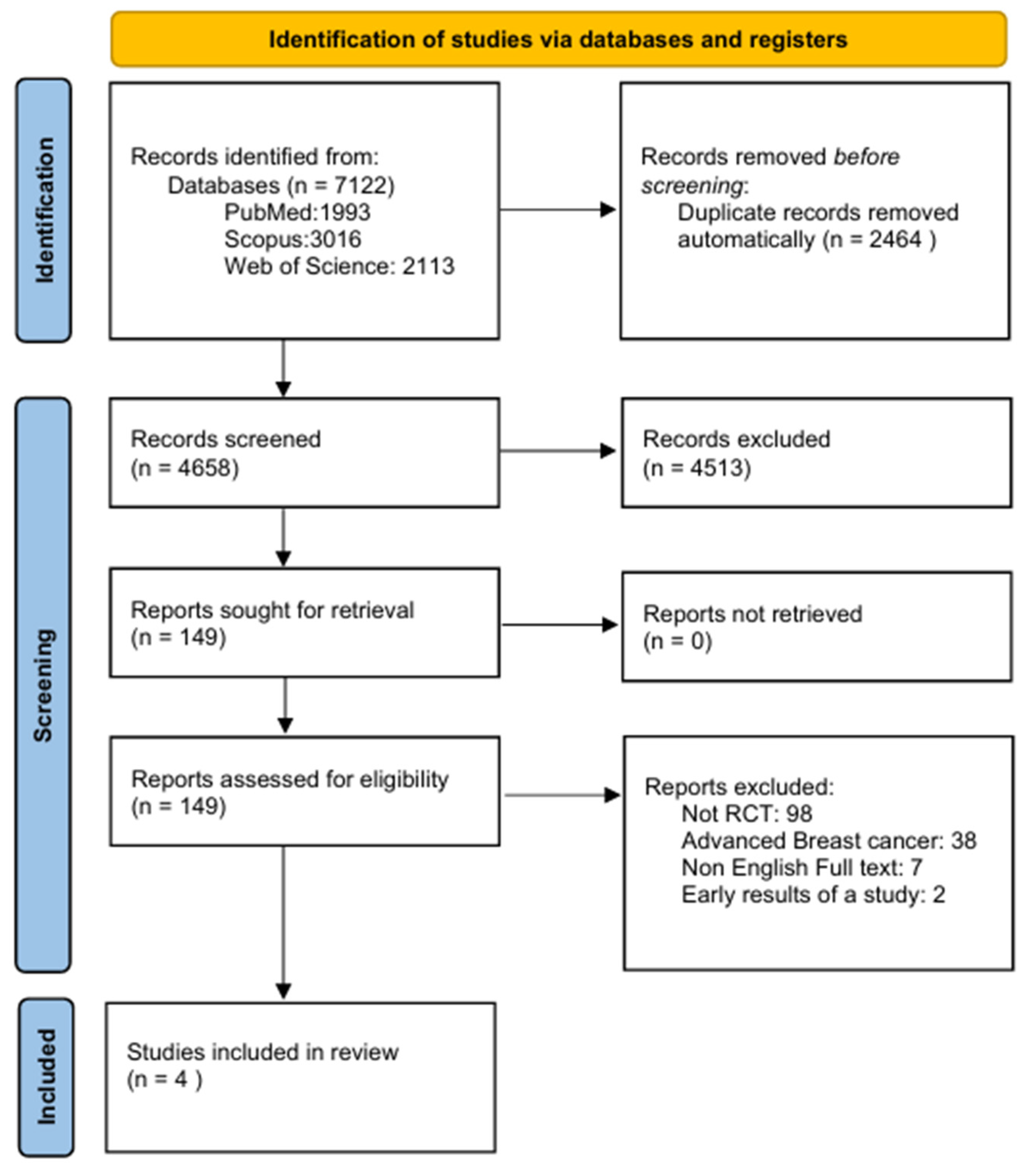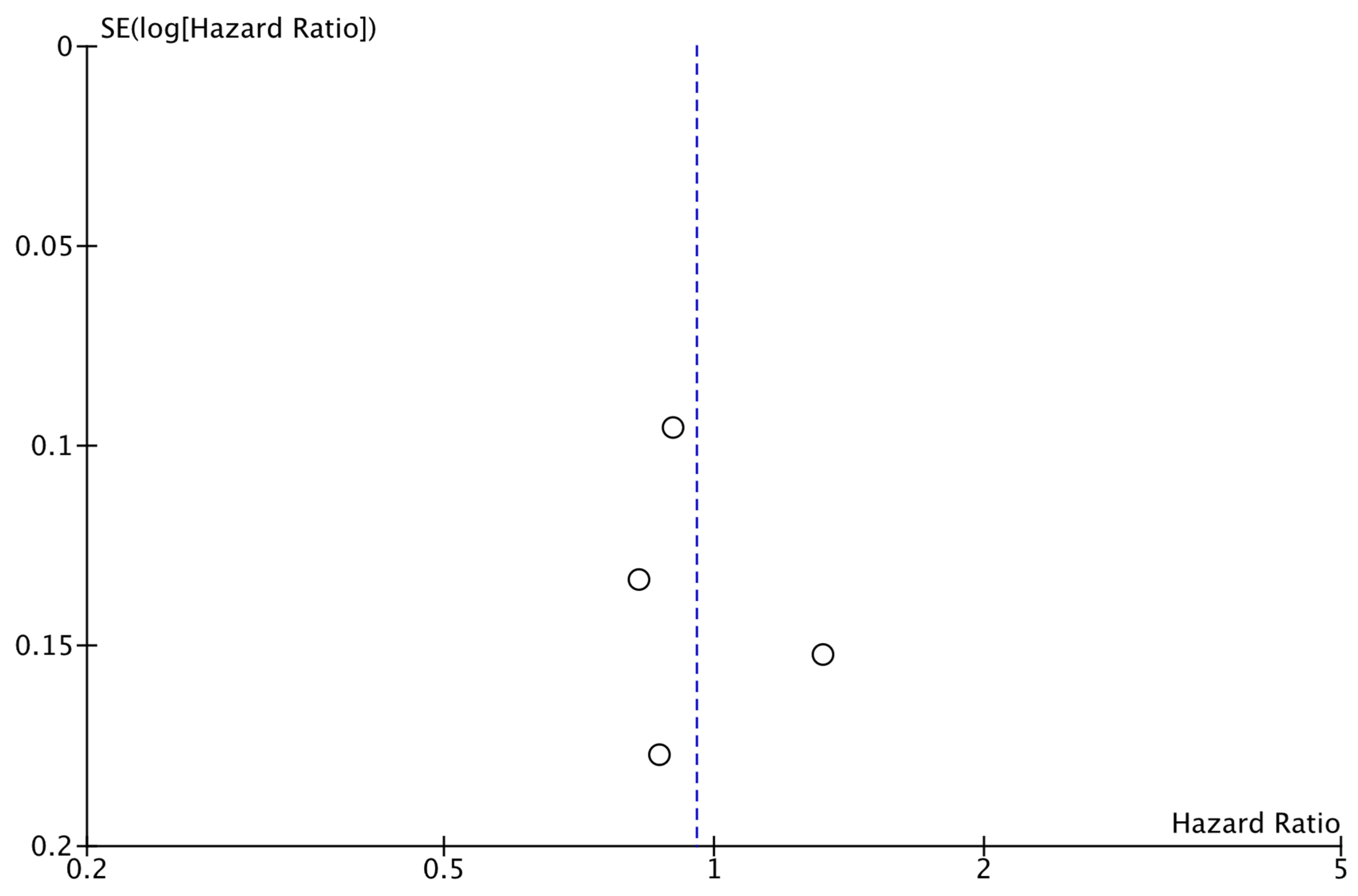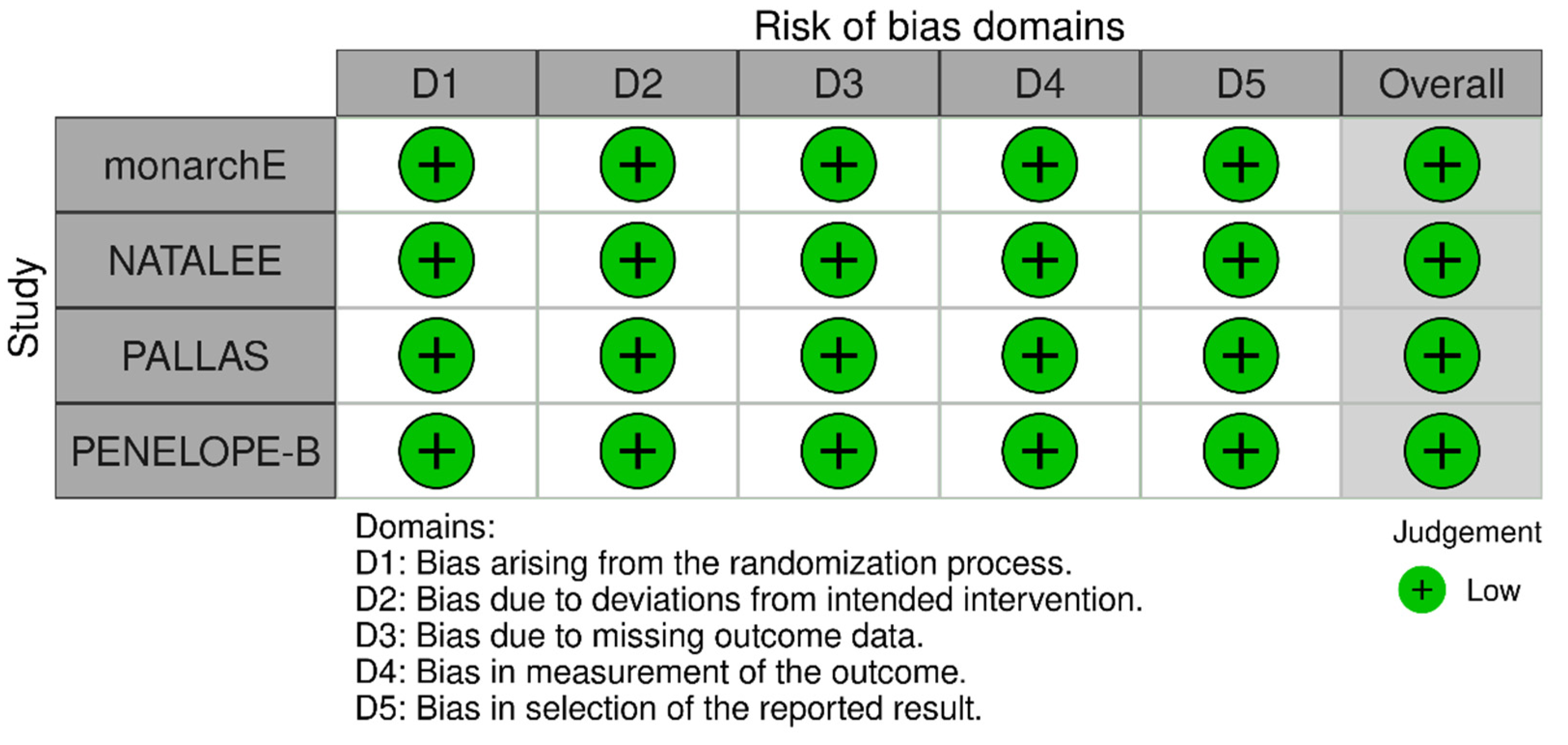CDK4/6 Inhibitors Plus Endocrine Therapy in Early-Stage HR+/HER2− Breast Cancer: Updated Meta-Analysis of Phase III Trials †
Simple Summary
Abstract
1. Introduction
2. Materials and Methods
2.1. Literature Search
2.2. Inclusion Criteria
2.3. Outcomes of Interest
2.4. Data Extraction
2.5. Quality of Studies and Publication Bias
2.6. Statistical Analysis
3. Results
3.1. Database Search
3.2. Study Characteristics
3.2.1. Demographics
3.2.2. Clinical Information
3.2.3. Adverse Effects
3.3. Outcomes
3.3.1. iDFS
3.3.2. DRFS
3.3.3. OS
3.4. Sensitivity Analyses
3.5. Risk of Bias
4. Discussion
5. Conclusions
Supplementary Materials
Author Contributions
Funding
Institutional Review Board Statement
Informed Consent Statement
Data Availability Statement
Conflicts of Interest
Abbreviations
| CDK4/6i | CDK4/6 inhibitors |
| ET | Endocrine therapy |
| DRFS | Distant recurrence-free survival |
| iDFS | Invasive disease-free survival |
| OS | Overall survival |
| HR+ | Hormone Receptor-positive |
| HER2− | Human Epidermal Growth Factor 2-negative |
| RCTs | Randomized controlled trials |
| CDKs | Cyclin-dependent kinases |
| ER+ | Estrogen receptor positive |
| Rb | Retinoblastoma protein |
| a/mBC | Advanced or metastatic breast cancer |
| PFS | Progression-free survival |
| ABC | Advanced breast cancer |
| DFS | Disease-free survival |
| HR | Hazard ratios |
References
- Cancer Factsheets in EU-27 Countries-2020|ECIS—European Cancer Information System. Available online: https://ecis.jrc.ec.europa.eu/cancer-factsheets-eu-27-countries-2020 (accessed on 10 January 2025).
- Sung, H.; Ferlay, J.; Siegel, R.L.; Laversanne, M.; Soerjomataram, I.; Jemal, A.; Bray, F. Global Cancer Statistics 2020: GLOBOCAN Estimates of Incidence and Mortality Worldwide for 36 Cancers in 185 Countries. CA A Cancer J. Clin. 2021, 71, 209–249. [Google Scholar] [CrossRef] [PubMed]
- Fasching, P.A.; Kreipe, H.; Del Mastro, L.; Ciruelos, E.; Freyer, G.; Korfel, A.; Chouaki, N.; Stoffregen, C.; Sapunar, F.; Cameron, D. Identification of Patients with Early HR+ HER2− Breast Cancer at High Risk of Recurrence. Geburtshilfe Frauenheilkd. 2024, 84, 164–184. [Google Scholar] [CrossRef] [PubMed]
- Sherr, C.J.; Roberts, J.M. CDK Inhibitors: Positive and Negative Regulators of G1-Phase Progression. Genes Dev. 1999, 13, 1501–1512. [Google Scholar] [CrossRef] [PubMed]
- Wang, X.; Zhao, S.; Xin, Q.; Zhang, Y.; Wang, K.; Li, M. Recent Progress of CDK4/6 Inhibitors’ Current Practice in Breast Cancer. Cancer Gene Ther. 2024, 31, 1283–1291. [Google Scholar] [CrossRef] [PubMed]
- Sammons, S.L.; Topping, D.L.; Blackwell, K.L. HR+, HER2– Advanced Breast Cancer and CDK4/6 Inhibitors: Mode of Action, Clinical Activity, and Safety Profiles. Curr. Cancer Drug Targets 2017, 17, 637–649. [Google Scholar] [CrossRef] [PubMed]
- Pu, D.; Xu, D.; Wu, Y.; Chen, H.; Shi, G.; Feng, D.; Zhang, M.; Liu, Z.; Li, J. Efficacy of CDK4/6 Inhibitors Combined with Endocrine Therapy in HR+/HER2− Breast Cancer: An Umbrella Review. J. Cancer Res. Clin. Oncol. 2024, 150, 16. [Google Scholar] [CrossRef] [PubMed]
- Wolff, A.C. CDK4/6 Inhibition in Early-Stage Breast Cancer: The New Standard? J. Clin. Oncol. 2020, 38, 3977–3979. [Google Scholar] [CrossRef] [PubMed]
- Gil-Gil, M.; Alba, E.; Gavilá, J.; De La Haba-Rodríguez, J.; Ciruelos, E.; Tolosa, P.; Candini, D.; Llombart-Cussac, A. The Role of CDK4/6 Inhibitors in Early Breast Cancer. Breast 2021, 58, 160–169. [Google Scholar] [CrossRef] [PubMed]
- Fasching, P.A.; Stroyakovskiy, D.; Yardley, D.; Huang, C.-S.; Crown, J.P.; Bardia, A.; Chia, S.; Im, S.-A.; Jimenez, M.M.; Xu, B.; et al. LBA13 Adjuvant Ribociclib (RIB) plus Nonsteroidal Aromatase Inhibitor (NSAI) in Patients (Pts) with HR+/HER2− Early Breast Cancer (EBC): 4-Year Outcomes from the NATALEE Trial. Ann. Oncol. 2024, 35, S1207. [Google Scholar] [CrossRef]
- Loibl, S.; Marmé, F.; Martin, M.; Untch, M.; Bonnefoi, H.; Kim, S.-B.; Bear, H.; McCarthy, N.; Melé Olivé, M.; Gelmon, K.; et al. Palbociclib for Residual High-Risk Invasive HR-Positive and HER2-Negative Early Breast Cancer—The Penelope-B Trial. J. Clin. Oncol. 2021, 39, 1518–1530. [Google Scholar] [CrossRef] [PubMed]
- Gnant, M.; Dueck, A.C.; Frantal, S.; Martin, M.; Burstein, H.J.; Greil, R.; Fox, P.; Wolff, A.C.; Chan, A.; Winer, E.P.; et al. Adjuvant Palbociclib for Early Breast Cancer: The PALLAS Trial Results (ABCSG-42/AFT-05/BIG-14-03). J. Clin. Oncol. 2022, 40, 282–293. [Google Scholar] [CrossRef] [PubMed]
- Rastogi, P.; O’Shaughnessy, J.; Martin, M.; Boyle, F.; Cortes, J.; Rugo, H.S.; Goetz, M.P.; Hamilton, E.P.; Huang, C.-S.; Senkus, E.; et al. Adjuvant Abemaciclib Plus Endocrine Therapy for Hormone Receptor–Positive, Human Epidermal Growth Factor Receptor 2–Negative, High-Risk Early Breast Cancer: Results From a Preplanned monarchE Overall Survival Interim Analysis, Including 5-Year Efficacy Outcomes. J. Clin. Oncol. 2024, 42, 987–993. [Google Scholar] [CrossRef] [PubMed]
- Moraes, F.C.A.D.; De Oliveira Almeida, G.; Alves, V.F.C.; Priantti, J.N.; Gomes, G.D.C.; Carnevalli, S.V.B.; Madeira, T.; Vilbert, M.; Stecca, C.; Figueroa Magalhães, M.C.; et al. Cyclin-Dependent Kinase 4/6 Inhibitors Plus Endocrine Therapy versus Endocrine Therapy Alone for HR-Positive, HER-2-Negative Early Breast Cancer: Meta-Analysis of Phase III Randomized Clinical Trials. J. Pers. Med. 2024, 14, 464. [Google Scholar] [CrossRef] [PubMed]
- Page, M.J.; McKenzie, J.E.; Bossuyt, P.M.; Boutron, I.; Hoffmann, T.C.; Mulrow, C.D.; Shamseer, L.; Tetzlaff, J.M.; Akl, E.A.; Brennan, S.E.; et al. The PRISMA 2020 Statement: An Updated Guideline for Reporting Systematic Reviews. BMJ 2021, 372, n71. [Google Scholar] [CrossRef] [PubMed]
- Sterne, J.A.C.; Savović, J.; Page, M.J.; Elbers, R.G.; Blencowe, N.S.; Boutron, I.; Cates, C.J.; Cheng, H.-Y.; Corbett, M.S.; Eldridge, S.M.; et al. RoB 2: A Revised Tool for Assessing Risk of Bias in Randomised Trials. BMJ 2019, 366, l4898. [Google Scholar] [CrossRef] [PubMed]
- Cochrane Handbook for Systematic Reviews of Interventions|Cochrane. Available online: https://www.cochrane.org/authors/handbooks-and-manuals/handbook (accessed on 6 October 2025).
- Higgins, J.P.T.; Thompson, S.G. Quantifying Heterogeneity in a Meta-Analysis. Stat. Med. 2002, 21, 1539–1558. [Google Scholar] [CrossRef] [PubMed]
- Adjuvant Palbociclib Plus Endocrine Therapy Did Not Show Benefit in Early HR+ HER2 Negative Breast Cancer. Available online: https://www.cancernetwork.com/view/adjuvant-palbociclib-plus-endocrine-therapy-did-not-show-benefit-in-early-hr-her2-negative-breast-cancer (accessed on 10 January 2025).
- Akhade, A.; Wambeke, S.V.; Gyawali, B. CDK 4/6 Inhibitors for Adjuvant Therapy in Early Breast Cancer—Do We Have a Clear Winner? Available online: http://ecancer.org/en/journal/editorial/124-cdk-4-6-inhibitors-for-adjuvant-therapy-in-early-breast-cancer-do-we-have-a-clear-winner (accessed on 10 January 2025).
- Staff, T.A.P. Final Analysis of PALLAS Trial: No Benefit of Adjuvant Palbociclib Plus Endocrine Therapy in Early Breast Cancer. Available online: https://ascopost.com/issues/march-10-2022-supplement-conference-highlights-sabcs-2021/final-analysis-of-pallas-trial-no-benefit-of-adjuvant-palbociclib-plus-endocrine-therapy-in-early-breast-cancer/ (accessed on 10 January 2025).
- Zhang, Z.; Golomb, L.; Meyerson, M. Functional Genomic Analysis of CDK4 and CDK6 Gene Dependency across Human Cancer Cell Lines. Cancer Res. 2022, 82, 2171–2184. [Google Scholar] [CrossRef] [PubMed]
- Helwick, C. PALLAS Trial: No Benefit Reported for Adjuvant Palbociclib in Stage IIA Hormone Receptor–Positive, HER2-Negative Breast Cancer. Available online: https://ascopost.com/issues/november-25-2022/pallas-trial-no-benefit-reported-for-adjuvant-palbociclib-in-stage-iia-hormone-receptor-positive-her2-negative-breast-cancer/ (accessed on 10 January 2025).
- George, M.A.; Qureshi, S.; Omene, C.; Toppmeyer, D.L.; Ganesan, S. Clinical and Pharmacologic Differences of CDK4/6 Inhibitors in Breast Cancer. Front. Oncol. 2021, 11, 693104. [Google Scholar] [CrossRef] [PubMed]
- Buller, W.; Pallan, L.; Chu, T.; Khoja, L. CDK4/6 Inhibitors in Metastatic Breast Cancer, a Comparison of Toxicity and Efficacy across Agents in a Real-World Dataset. J. Oncol. Pharm. Pract. 2023, 29, 1825–1835. [Google Scholar] [CrossRef] [PubMed]
- Pilehvari, A.; You, W.; Kimmick, G.G.; Bonilla, G.; Anderson, R. Unveiling the Cost-Effectiveness of CDK4/6 Inhibitors in Treating Patients with HR+/HER2- Metastatic Breast Cancer: A Closer Look at Nonmedication Expenses. J. Clin. Oncol. 2024, 42, 1532. [Google Scholar] [CrossRef]
- Masurkar, P.P.; Prajapati, P.; Canedo, J.; Goswami, S.; Earl, S.; Bhattacharya, K. Cost-Effectiveness of CDK4/6 Inhibitors in HR+/HER2- Metastatic Breast Cancer: A Systematic Review and Meta-Analysis. Curr. Med. Res. Opin. 2024, 40, 1753–1767. [Google Scholar] [CrossRef] [PubMed]
- Sahin, T.K.; Rizzo, A.; Guven, D.C.; Aksoy, S. Post-Progression Treatment Options after CDK4/6 Inhibitors in Hormone Receptor-Positive, HER2-Negative Metastatic Breast Cancer. Cancer Treat. Rev. 2025, 135, 102924. [Google Scholar] [CrossRef] [PubMed]
- Giugliano, F.; De Angelis, C.; Pistilli, B.; Viale, G.; Bianchini, G.; Giuliano, M.; Malorni, L.; Taurelli Salimbeni, B.; Esposito, A.; Giordano, A.; et al. Overcoming Resistance to CDK4/6 Inhibitors in Hormone Receptor Positive, HER2 Negative Breast Cancer: Innovative Combinations and Emerging Strategies. Cancer Treat. Rev. 2025, 139, 102980. [Google Scholar] [CrossRef] [PubMed]








| Study ID YOP | monarchE 2024 | NATALEE 2024 | PENELOPE-B 2021 | PALLAS 2021 |
|---|---|---|---|---|
| Number (intervention) | 2808 | 2549 | 631 | 2884 |
| Number (control) | 2829 | 2552 | 619 | 2877 |
| Male (intervention) | 21 | 11 | 0 | 17 |
| Male (control) | 15 | 9 | 0 | 19 |
| Female (intervention) | 2787 | 2538 | 631 | 2867 |
| Female (control) | 2814 | 2543 | 619 | 2858 |
| Age (intervention) Median (IQR) | 51 (44–60) | 52 (24-90) | 49 (22–76) | 52 (45–61) |
| Age (control) Median (IQR) | 51 (44–60) | 52 (24-89) | 48 (19–79) | 52 (45–60) |
| Drugs (intervention) | Abemaciclib + ET | Ribociclib + ET | Palbociclib + ET | Palbociclib + ET |
| Drugs (control) | ET | ET | ET | ET |
| Duration (intervention) | 2 years | 3 years | 1 year | 2 years |
| Duration (control) | 5 years | 5 years | 5 years | 5 years |
| Dosage (intervention) | 150 mg | 400 mg | 125 mg | 125 mg |
| twice daily | once daily | once daily | once daily |
| Study ID YOP | monarchE 2024 | NATALEE 2024 | PENELOPE-B 2021 | PALLAS 2021 |
|---|---|---|---|---|
| Pre-menopausal (intervention) | 1221 | 1115 | 300 | 1303 |
| Pre-menopausal (control) | 1232 | 1123 | 316 | 1323 |
| Post-menopausal (intervention) | 1587 | 1424 | 331 | 1562 |
| Post-menopausal (control) | 1597 | 1420 | 303 | 1534 |
| Grade (intervention) | Grade 1: 209 Grade 2: 1377 Grade 3: 1086 | Grade X: 30 Grade 1: 218 Grade 2: 1458 Grade 3: 521 Not assessed: 292 Data missing: 30 | Grade 1: 31 Grade 2: 355 Grade 3: 237 Missing: 8 | Grade X: 118 Grade 1–2: 1926 Grade 3: 836 Unknown: 4 |
| Grade (control) | Grade 1: 216 Grade 2: 1395 Grade 3: 1064 | Grade X: 32 Grade 1: 240 Grade 2: 1451 Grade 3: 549 Not assessed: 258 Data missing: 22 | Grade 1: 36 Grade 2: 330 Grade 3: 245 Missing: 8 | Grade X: 137 Grade 1–2: 1971 Grade 3: 769 Unknown: 0 |
| Lymph node status (intervention) | Ν1: 1118 Ν2: 1107 Ν3: 575 | NX: 272 N0: 694 N1: 1050 N2 or N3: 483 Data missing: 50 | N0: 66 N1: 433 N2: 80 N3: 52 | Ν0: 365 Ν1: 1431 Ν2: 700 Ν3: 386 ΝΧ: 1 Unknown: 1 |
| Lymph node status (control) | Ν1: 1142 Ν2: 1126 Ν3: 554 | NX: 264 N0: 737 N1: 1049 N2 or N3: 467 Data missing: 35 | N0: 71 N1: 417 N2: 82 N3: 49 | ΝΧ: 0 Ν0: 385 Ν1:1411 Ν2:709 Ν3: 372 Unknown: 0 |
| Ki 67 (intervention) | <20%: 953 ≥20%: 1262 | ≤20%: 1199 >20%: 920 | ≤15%: 470 >15%: 161 | Not available |
| Ki 67 (control) | <20%: 974 ≥20%:1233 | ≤20%: 1236 >20%: 937 | ≤15%: 461 >15%: 158 | Not available |
| Follow up time (intervention) Median (IQR) | Median (IQR): 54 (49–59) | Median: 44.2 months | Median: 42.8 months | Median (IQR): 31 (24.5–37.3) months |
| Follow up time (control) | 54 (49–59) | 44.2 months | 42.8 months | 31 (24.5–37.3) months |
| Outcome | Preferred Model Used Outcome | Alternative (Sensitivity) Model |
|---|---|---|
| iDFS | RE HR 0.80; 95% CI: 0.67–0.96; p = 0.01; I2 = 78% | FE HR 0.77; 95% CI: 0.71–0.84; p < 0.001; I2 = 78% |
| DRFS | RE HR 0.79; 95% CI: 0.61–1.02; p = 0.07; I2 = 86% | FE HR 0.76; 95% CI: 0.69–0.84; p < 0.001; I2 = 86% |
| OS | RE HR 0.95; 95% CI: 0.79–1.16; p = 0.63; I2 = 52% | FE HR 0.94; 95% CI: 0.83–1.07; p = 0.36; I2 = 52% |
| Outcome | Leaving monarchE Out | Leaving NATALEE Out | Leaving PALLAS Out | Leaving PENELOPE-B Out |
|---|---|---|---|---|
| Model used Outcome | Model used Outcome | Model used Outcome | Model used Outcome | |
| iDFS | RE HR 0.86; 95% CI: 0.70–1.04; p = 0.12; I2 = 71% | RE HR 0.84; 95% CI: 0.66–1.07; p = 0.16; I2 = 84% | RE HR 0.75; 95% CI: 0.6–0.88; p < 0.001; I2 = 64% | RE HR 0.77; 95% CI: 0.63–0.94; p = 0.01; I2 = 81% |
| OS | RE HR 0.98; 95% CI: 0.73–1.32; p = 0.91; I2 = 66% | RE HR 1.01; 95% CI: 0.78–1.29; p = 0.97; I2 = 60% | FE HR 0.88; 95% CI: 0.76–1.01; p = 0.06; I2 = 0% | RE HR 0.98; 95% CI: 0.77–1.25; p = 0.87; I2 = 67% |
Disclaimer/Publisher’s Note: The statements, opinions and data contained in all publications are solely those of the individual author(s) and contributor(s) and not of MDPI and/or the editor(s). MDPI and/or the editor(s) disclaim responsibility for any injury to people or property resulting from any ideas, methods, instructions or products referred to in the content. |
© 2025 by the authors. Licensee MDPI, Basel, Switzerland. This article is an open access article distributed under the terms and conditions of the Creative Commons Attribution (CC BY) license (https://creativecommons.org/licenses/by/4.0/).
Share and Cite
Alexiou, S.; Mavrovounis, G.; Christodoulopoulos, G.; Perifanou, S.; Saloustros, E. CDK4/6 Inhibitors Plus Endocrine Therapy in Early-Stage HR+/HER2− Breast Cancer: Updated Meta-Analysis of Phase III Trials. Cancers 2025, 17, 3538. https://doi.org/10.3390/cancers17213538
Alexiou S, Mavrovounis G, Christodoulopoulos G, Perifanou S, Saloustros E. CDK4/6 Inhibitors Plus Endocrine Therapy in Early-Stage HR+/HER2− Breast Cancer: Updated Meta-Analysis of Phase III Trials. Cancers. 2025; 17(21):3538. https://doi.org/10.3390/cancers17213538
Chicago/Turabian StyleAlexiou, Stamatia, Georgios Mavrovounis, Georgios Christodoulopoulos, Stamatia Perifanou, and Emmanouil Saloustros. 2025. "CDK4/6 Inhibitors Plus Endocrine Therapy in Early-Stage HR+/HER2− Breast Cancer: Updated Meta-Analysis of Phase III Trials" Cancers 17, no. 21: 3538. https://doi.org/10.3390/cancers17213538
APA StyleAlexiou, S., Mavrovounis, G., Christodoulopoulos, G., Perifanou, S., & Saloustros, E. (2025). CDK4/6 Inhibitors Plus Endocrine Therapy in Early-Stage HR+/HER2− Breast Cancer: Updated Meta-Analysis of Phase III Trials. Cancers, 17(21), 3538. https://doi.org/10.3390/cancers17213538







